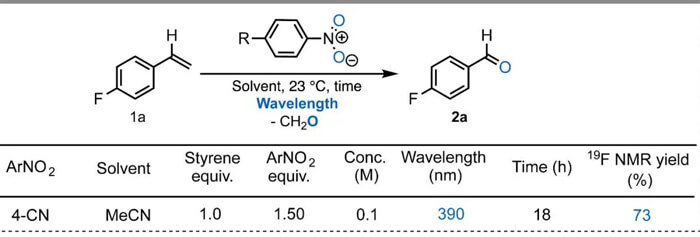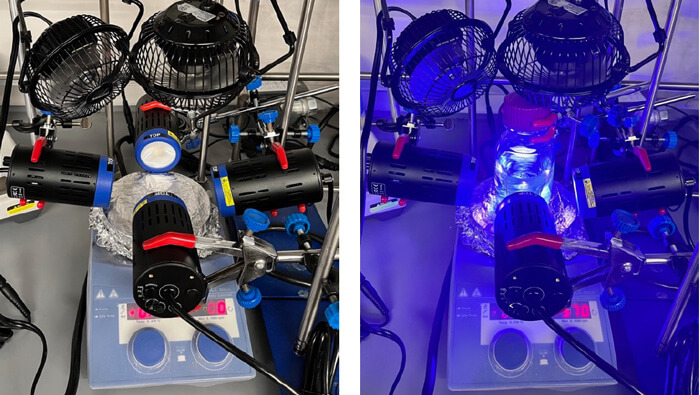Beautiful Chemistry Issue 1| Photoinduced Alkene Cleavage Using Nitroarenes
The oxidative cleavage of olefins is an important transformation in organic synthesis to obtain carbonyl functional groups such as ketones and aldehydes. The current used approaches, such as ozonolysis and Lemieux-Johnson Oxidation suffer from many significant limitations. Thus the development of a mild, general, and practical approach is still highly warranted.

Oxidative Cleavage of Alkenes[1]
A recent report from Parasram group (J. Am. Chem. Soc. 2022, 144, 15437.) indicated a visible light-induced anaerobic cleavage of alkenes by using economical and bench-stable nitroarenes as oxygen transfer reagents.
The authors used 4-fluorostyrene as the control olefin to optimize the reaction conditions. They found 4-CN-nitrobenzene was the best nitroarene for such transformations. A few other nitroarenes bearing strong electron-withdrawing group gave satisfactory results, while nitroarene bearing electron-donating group gave poor conversion.

Optimization of reaction condition[1]
By using the 4-fluorostyrene and 4-CN-nitrobenzene reaction pair, further optimizations on the solvent, equivalency, concentration, wavelength screen and reaction time established the optimal reaction conditions.

Optimization of reaction condition[1]
The reaction scope was investigated: styrenes, α-methylstyrenes, cyclic styrenes, tri- and tetra-substituted styrenes containing both electron-donating and electron-withdrawing substituents worked well to give corresponding aldehydes and ketones in good yields. Sensitive functional groups such as hydroxyl, carboxylic acid, halides and boronic esters were well tolerated. Styrenes with tethered π-systems resulted in regioselective cleavage of the styrenyl alkenes, such regioselectivity represents a major improvement on previously reported oxidative cleavage methods.

Scope of the Nitroarene Induced Anaerobic Cleavage of Alkenes[1]
The anaerobic cleavage of unactivated alkenes, however, gave poor yields due to the low reactivity.

Scope of the Nitroarene Induced Anaerobic Cleavage of Alkenes[1]
Almost at the same time, Leonori and co-workers published their work (Nature 2022, 610, 81) on this subject and showed their way to solve this issue: in their research, they found a strong linear free-energy relationship between the electronic character of the nitroarene and the reaction rate. The reactivity profile of nitroarenes as photo-responsive oxidants can be tuned as 3-CN-5-CF3 nitrobenzene, to further amplify the electrophilic character of their excited states. Indeed, the 3-CN-5-CF3 nitrobenzene worked well with unactivated olefins.

Mechanistic experiments[2]
Leonori and co-workers also did thorough evaluation on the site selectivity of substrates containing more than one C–Cπ site. They concluded that the regioselectivity depends on the electronic nature of the nitroarene and the two alkenes. The oxidative cleavage occurred at the more electron-rich double bond; in addition, the selectivity increases when using less electrophilic nitroarene. As a result, modulation of the nitroarene electronics can be used to amplify narrow reactivity differences when substrate control is difficult to implement.

Achieving alkene selectivity[2]
After detailed mechanistic studies, the Parasram group proposed a biradical [3+2] cycloaddition to form dioxazolidine; polar fragmentation of dioxazolidine, followed by 1,3-dipolar cycloaddition to give 1,4,2-dioxazolidine intermediates, which fragment to the desired carbonyl products.

Proposed Mechanism[1]
To evaluate the scalability of this methodology, both teams performed the reaction on multigram scale. Despite reported challenges for scaling up photochemical reactions, the reaction went smoothly at 10 mmol scale with the unmodified reaction conditions using a simple batch setup.

Reaction setup[1]
In summary, the unique reactivity of the photo-induced nitroarene biradicals enabled this mild, safe, and practical procedure to selectively cleave alkenes under anaerobic conditions, thus providing a powerful and reliable alternative tool to oxidatively cleave olefins.
Medicilon Photochemistry Platform
Medicilon has been vigorously developing new technologies over the years, integrating emerging methods of green chemistry into its services, using currently popular photoredox chemistry, electrochemisty, catalyst screening, continuous reactions, etc., to provide our customers with high-quality economic solutions.
❖Highly experienced in different types of photochemistry reactions
❖Full capacity for the synthesis of a variety of catalysts for photocatalytic reactions
❖Strong expertise in photoredox chemistry
References:
[1] Photoinduced oxygen transfer using nitroarenes for the anaerobic cleavage of alkenes
Dan E Wise, Emma S Gogarnoiu, Alana D Duke, Joshua M Paolillo, Taylor L Vacala, Waseem A Hussain, Marvin Parasram
J. Am. Chem. Soc. 2022, 144 (34), 15437-15442. doi: 10.1021/jacs.2c05648
[2] Photoexcited nitroarenes for the oxidative cleavage of alkenes
Alessandro Ruffoni, Charlotte Hampton, Marco Simonetti, Daniele Leonori
Nature 2022, 610 (7930), 81-86. doi: 10.1038/s41586-022-05211-0

 The oxidative cleavage of olefins is an important transformation in organic synthesis to obtain carbonyl functional groups such as ketones and aldehydes. The current used approaches, such as ozonolysis and Lemieux-Johnson Oxidation suffer from many significant limitations. Thus the development of a mild, general, and practical approach is still highly warranted.
The oxidative cleavage of olefins is an important transformation in organic synthesis to obtain carbonyl functional groups such as ketones and aldehydes. The current used approaches, such as ozonolysis and Lemieux-Johnson Oxidation suffer from many significant limitations. Thus the development of a mild, general, and practical approach is still highly warranted.

 浙公网安备 33010602011771号
浙公网安备 33010602011771号